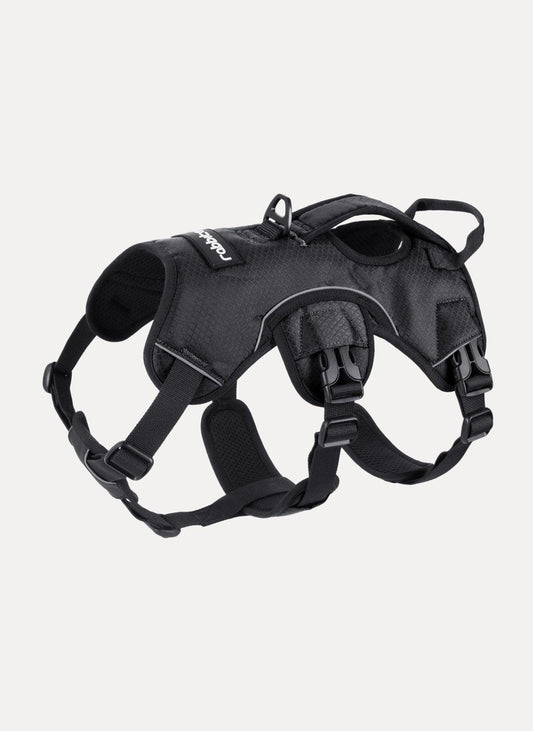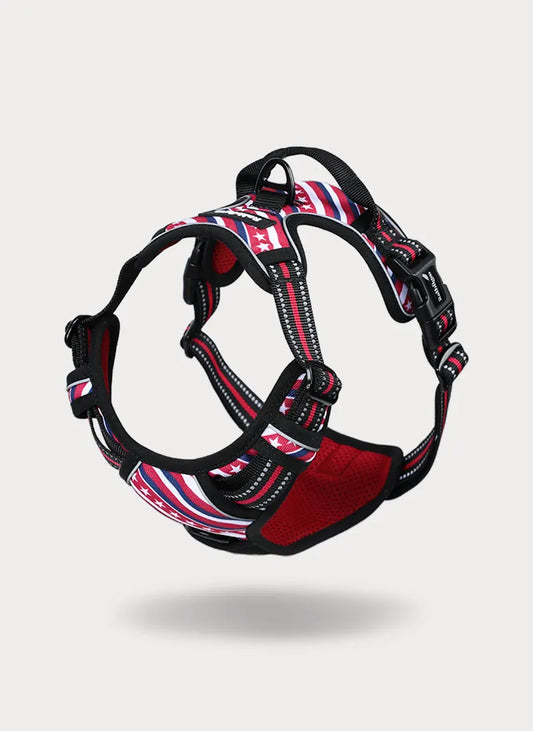Types of Rabbitgoo Dog Harnesses
In recent years, dog harnesses have gained immense popularity as a safer and more comfortable alternative to collars (And we agree with this opinion). The only issue is there are various types of harnesses front clip, back clip, dual clip, step-in, and so forth. How a person can choose the right option?
Also, even if you succeed in choosing the right harness for your dog, the next question is how to put it on. But you don’t have to worry about all these issues. Here’s a brief answer to your question.
|
Key-Takeaways
|
|
There are various types of dog harnesses, but the main ones are five. ● Back-clip harness: It has one clip on the back. ● Front-clip harness: It has a clip on the front side. ● Dual-clip harness: This harness has dual-clips (front and back). ● Step-in harness: Easy to put on by having the dog step into it. ● Y-shape harness: It features a Y-shape design. |
If you want a detailed guide, just scroll down the page, as we’ll be explaining the main types of dog harnesses and how to put them on.
Five Main Types of Dog Harnesses
Below, you can read about the five main types of dog harnesses.
1. Back Clip Dog Harnesses
Back clip harnesses are one of the most common types of dog harness. They have the leash clip point on the back side (dog’s back). It means, even if your dog pulls, there will be no pressure on the neck.
With a back clip dog harness, the leash won’t tangle around the legs. It also provides good control for trained dogs that don’t pull excessively.
2. Front Clip Dog Harnesses
Front clip harnesses are the complete opposite of the back clip dog harness. It’s because the leash attachment clip is now on the front (on the chest area).
This type of harness provides much better control for training purposes, especially if your dog loves to pull. Whenever your dog pulls or tries to escape, you can turn their attention towards you again by pulling the leash.
3. Dual Clip Dog Harnesses
A dual clip harness is a combination of both the front clip and the back clip harness. Simply, because it has clips on both sides (just like our Rabbitgo no-pull dog harness), allowing you to control the dog's movement as per the situation.
For example, you can use the back clip for a casual morning walk and the front clip when you’re training your dog. If you want more control, you can use both clips at the same time.
4. Step-in Dog Harnesses
Now coming to the step-in dog harness, also known as the step-through harness. As the name suggests, the specialty of this harness is that your dog can easily step through it.
You simply place their paws inside the designated openings, and once they've stepped in, you close the clip at the back. This is a perfect option for dog parents whose pups don’t enjoy the hassle of getting into traditional harnesses.
5. Y-Shape Dog Harnesses
Y-shape dog harness features a Y-shape design that distributes the leash pressure evenly across the dog's chest and shoulders.
They are often preferred for their comfort and can have either back or front clip attachments, or sometimes both. What pet owners like most about it, these harnesses are easy to put on and can be adjusted for a better fit.
How to Put Harness On Your Dog? Step-by-Step Guide
So now you know about the main types of dog harnesses, let’s move towards another main question, how to put harness on your dog.
1. Introduce the Harness
If your dog is uneasy around harnesses, this step is crucial. However, if they're already comfortable, you can skip it. Here's how to properly introduce the harness:
- Grab your pup's favorite treats (or use ones from your pantry).
- Place the harness in an area where your dog feels at ease, and call them over.
- If they hesitate to approach, show them the treats in your hand.
- Once they come for the treats, offer praise and more rewards.
- After a few minutes of them being near the harness, place treats around it.
- As your dog moves closer to eat the treats near the harness, encourage this behavior.
- Continue placing treats by the harness until your dog shows no fear and willingly touches it.
The key is using positive reinforcement to create a pleasant association with the harness at your dog's own pace. With time and patience, they'll view it as no big deal.
2. Put on Dog Harnesses
Since your dog is comfortable having a harness around them, you can put a harness on. But before this, get your dog in the right position means standing comfortably then follow the process below:
For the back clip, dual clip, and front clip harnesses
- Hold the harness from the back clip (or a handle).
- Put the dog's head through the openings of the harness.
- Hold one side of the leg (front side legs), lift it slightly, and place it through the loops. Follow the same process for the other leg.
- Now buckle up the harness and that’s it.
For step-in harness
- Place the harness on a flat ground.
- Have your dog stand inside the harness loop.
- Lift the harness up and over their head.
- Guide their front legs through the openings.
- Adjust and buckle the harness for a comfortable fit.
For Y-Shape Harness
- Get your dog in the standing position.
- Guide their head through the neck opening.
- Bring the straps under their belly and connect the buckles.
3. Adjust the Harness
The third step is to adjust the harnesses. You can easily do this using the buckle and adjustment feature of the harness. However, just ensure you don’t have to tighten the harness so much that it suffocates the dog. The harness should be loose enough to add two fingers.
Final Thoughts
We hope you’ve found the answer to what are the main types of dog harnesses and how to put them on. We’ve explained everything in detail above, however, if there’s still any confusion. Don’t worry, just reach out to us, and we'll be happy to provide further clarification or assistance.
FAQs
● Do dogs wear harnesses all the time?
No, dogs don’t wear harnesses all the time. Harnesses are only meant for situations when you want to control and secure the dog, like when you’re walking, training, or on a camping trip, etc.
● How to choose a good harness?
To choose a good harness, first you need to understand your requirements, and what type of harness you need. Do you want full control over the dog, or just want a harness for a daily walk?
If it’s only about casual walking, a back-clip harness is a good option. While for training dual-clip harnesses, front-clip harnesses are best. You should also consider factors like size, material, ease of use, and your dog's specific needs.
● Is it OK to leave a harness on the dog?
It's generally not recommended to leave the harness on your dog for a long period. Harnesses can cause skin irritation if left on too long. It's best to only have your dog wear the harness during activities that require it, like walks or training sessions, and remove it when back inside.
See more detials in Collar vs Harness for Dogs: Which is Safer?





